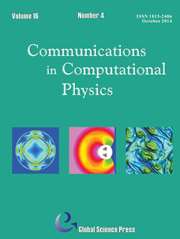Crossref Citations
This article has been cited by the following publications. This list is generated based on data provided by
Crossref.
Hiptmair, Ralf
2015.
Computational Electromagnetism.
Vol. 2148,
Issue. ,
p.
1.
Fuentes, Federico
Keith, Brendan
Demkowicz, Leszek
and
Nagaraj, Sriram
2015.
Orientation embedded high order shape functions for the exact sequence elements of all shapes.
Computers & Mathematics with Applications,
Vol. 70,
Issue. 4,
p.
353.
Arnold, Douglas N.
Boffi, Daniele
and
Bonizzoni, Francesca
2015.
Finite element differential forms on curvilinear cubic meshes and their approximation properties.
Numerische Mathematik,
Vol. 129,
Issue. 1,
p.
1.
Chan, Jesse
Wang, Zheng
Modave, Axel
Remacle, Jean-Francois
and
Warburton, T.
2016.
GPU-accelerated discontinuous Galerkin methods on hybrid meshes.
Journal of Computational Physics,
Vol. 318,
Issue. ,
p.
142.
Cohen, Gary
and
Pernet, Sébastien
2017.
Finite Element and Discontinuous Galerkin Methods for Transient Wave Equations.
p.
39.
Ainsworth, Mark
and
Fu, Guosheng
2017.
A lowest-order composite finite element exact sequence on pyramids.
Computer Methods in Applied Mechanics and Engineering,
Vol. 324,
Issue. ,
p.
110.
Arbogast, Todd
and
Tao, Zhen
2019.
Construction of
$$H({\mathrm{div}})$$
H
(
div
)
-conforming mixed finite elements on cuboidal hexahedra.
Numerische Mathematik,
Vol. 142,
Issue. 1,
p.
1.
Devloo, Philippe R.B.
Durán, Omar
Gomes, Sônia M.
and
Ainsworth, Mark
2019.
High-order composite finite element exact sequences based on tetrahedral–hexahedral–prismatic–pyramidal partitions.
Computer Methods in Applied Mechanics and Engineering,
Vol. 355,
Issue. ,
p.
952.
Arbogast, Todd
and
Tao, Zhen
2019.
A direct mixed–enriched Galerkin method on quadrilaterals for two-phase Darcy flow.
Computational Geosciences,
Vol. 23,
Issue. 5,
p.
1141.
Remy Bernard Devloo, Philippe
Durán, Omar
Monteiro Farias, Agnaldo
and
Maria Gomes, Sônia
2020.
H(div) finite elements based on nonaffine meshes for 3D mixed formulations of flow problems with arbitrary high order accuracy of the divergence of the flux.
International Journal for Numerical Methods in Engineering,
Vol. 121,
Issue. 13,
p.
2896.
Jaśkowiec, Jan
and
Sukumar, N.
2021.
High‐order symmetric cubature rules for tetrahedra and pyramids.
International Journal for Numerical Methods in Engineering,
Vol. 122,
Issue. 1,
p.
148.
Toth, Laszlo Levente
and
Dyczij-Edlinger, Romanus
2021.
The mixed-order serendipity finite element for H(curl)-conforming hexahedra.
p.
1.
Sáez-Mischlich, G.
Sierra-Ausín, J.
and
Gressier, J.
2022.
The Spectral Difference Raviart–Thomas Method for Two and Three-Dimensional Elements and Its Connection with the Flux Reconstruction Formulation.
Journal of Scientific Computing,
Vol. 93,
Issue. 2,
Du, Zhijie
and
Duan, Huoyuan
2023.
A stabilized finite element method on nonaffine grids for time-harmonic Maxwell’s equations.
BIT Numerical Mathematics,
Vol. 63,
Issue. 4,
Taraschi, G.
Correa, M.R.
Pinto, A.S.
and
Faria, C.O.
2024.
A global H(div)-conforming finite element post-processing for stress recovery in nearly incompressible elasticity.
Applied Mathematics and Computation,
Vol. 470,
Issue. ,
p.
128587.


